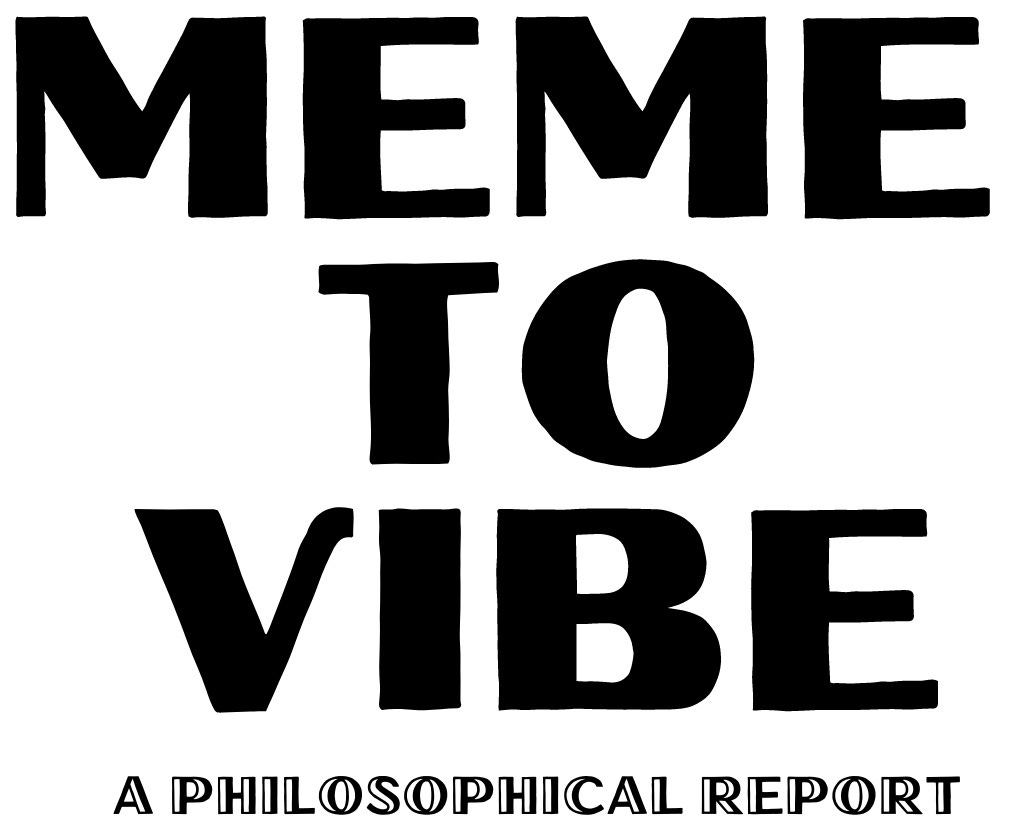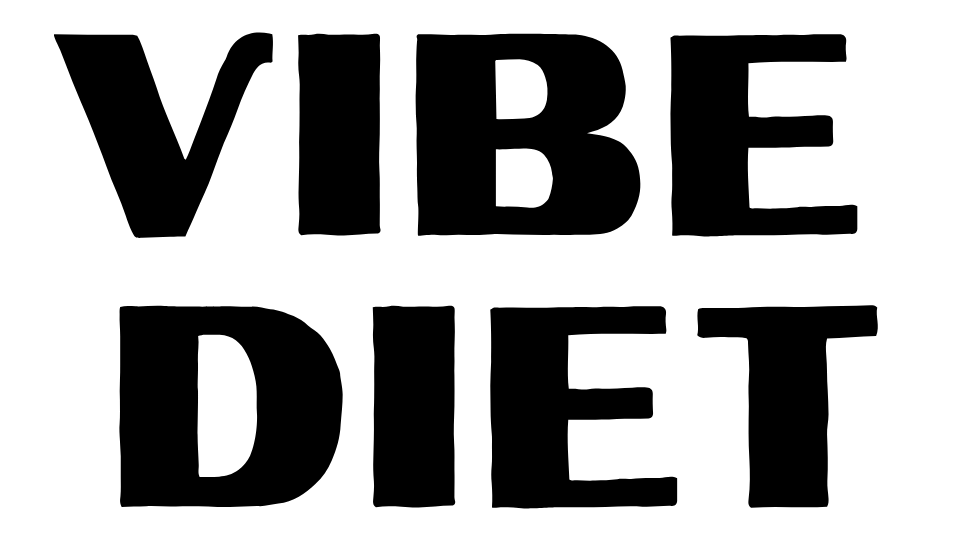Meme to Vibe: A Philosophical Report
Vibe. “A distinctive feeling or quality capable of being sensed. This place has a good/bad vibe. She gave me a weird vibe.” - Merriam-Webster
Vibing. “Have a good time with good vibes.” - Slang Dictionary
Vibe check. “A slang term used to invite people to express their present emotional state.” - Know Your Meme
Vibe shift. “A vibe shift is the catchy but sort of too-cool term [Sean] Monahan uses for a relatively simple idea: In the culture, sometimes things change, and a once-dominant social wavelength starts to feel dated.” - Allison P. Davis, “A Vibe Shift Is Coming. Will Any of Us Survive It?”
I like vibe words. They feel good to say—vibe, vibes, vibing. I get a sense of what it means immediately, and as the Merriam-Webster definition indicates, it is about something sensed. What is being sensed is nebulous and hard to put into words, but many have been trying. Here are a few recent attempts...
Kyle Chayka in The New Yorker: “Vibes are a medium for feeling, the kind of abstract understanding that comes before words put a name to experience. That pre-linguistic quality makes them well suited to a social-media landscape that is increasingly prioritizing audio, video, and images over text.”
Melanie Bühler in Mousse Magazine: “Being attuned to a “vibe” means partaking in a shared reality, but it’s more than that. It involves picking up on the lingering notes of that shared reality, on the je ne sais quoi that is still in the air after most other things have dissipated.”
Mitch Therieau in The Drift: “[V]ibe is primarily about the spread and creep of diffuse feelings through shared space. Vibes are “caught” or “given off” from one body to another; the gnomic phrase “vibe check” is, among other things, an invitation to share one’s feelings, to put the vibes one is emanating into words.”
The consensus is that the word is an overused catchall, engendering many lazy phrases: the vibes are off, it’s not a vibe, such a vibe, don't doubt your vibe, just vibe, etc. All this vibe talk was getting too much for some. Gawker’s editor banned the word for internal use in 2021, and The New York Times' first prediction for 2023: No more ‘vibes.’
The word did not go away in 2021. It will stay in 2023. Robin James, a feminist philosopher and critical theorist, is optimistic about a “vibe episteme” forming, arguing that the word’s popularity is a form of “lay phenomenology.” I agree. I also agree with Nick Burns, who defended the use of the word in The New Statesman, arguing we should make do with the words emerging from our “sentimentally stunted age,” regardless of how woo-woo they sound.
The word vibe is best understood as a “mongrel concept,” a term Ned Block, a philosopher in Consciousness Studies, uses to refer to a word that jumbles up many concepts while pointing to numerous phenomena. I do not think this is a bad thing. If denotative accuracy is the aim, then yes, the word leaves something to be desired. On the other hand, if connotative freedom is valued, the collective has picked a good word.
This mongrel concept is a portal from propositional to non-propositional knowledge. Propositional knowledge is knowledge encoded into truth claims, has a universal quality, and is abstracted beyond context. Non-propositional knowledge falls outside the propositional, which includes what cognitive scientist John Vervake calls perspectival knowledge: a knowledge that honors the here and now, engaging in “salience landscaping,” our sensing what is relevant for us in whatever context we find ourselves in.
To not bury the lede further, here is what I sense is happening with the “overuse” of vibe-related words: a “vibe consciousness” is collectively forming. This is not a new thing but an old thing, being rediscovered, understood, and expressed in new ways. This philosophical report will give examples of how this vibe consciousness is emerging and how we can encourage its emergence with wisdom.
Vibe Consciousness > Meme Consciousness
The recent focus on vibes postdates another mongrel concept in cultural use: memes. The colloquial meaning narrowly refers to viral images and videos shared on the internet. The Dawkinsian meaning broadly refers to “units of cultural transmission.” What is the difference between memes and vibes? Memes are cultural information the mind perceives, coupled with an urge to replicate them. Vibes are cultural “exformation” the body receives, coupled with a choice to experience them.
Science writer Tor Nørretranders coined exformation, an abbreviation of explicitly discarded information, describing it in the following way: “Exformation is everything we do not actually say but have in our heads [and bodies] when or before we say anything at all. Information is the measurable, demonstrable utterance we actually come out with.” I am repurposing the term to include everything that gets exchanged that cannot be encoded through measurable and demonstrable utterances like propositional knowledge.
An undue focus on memes brings about a “meme consciousness,” which is the predominant mode of consciousness for an “extremely online person,” a person impulsively engaging in internet culture, or what is called “pathological internet use.” This type of internet usage comes with an increased reduction of meaningful relationships IRL (“in real life”), with an increased investment in social media use AFRL (“away from real life”).
The epiphenomena of meme consciousness - its “three sins” - include…
Zombie Scrolling. The security software company McAfee coined Zombie Scrolling Syndrome in 2016 to describe the phenomena of “mindless scrolling out of habit with no real destination or benefit.”
Doomscrolling. The phenomena of excessively looking at negative news online about the putatively despairing state of the world.
Pornification. This is a phrase from Korean-born German philosopher Byung-Chul Han, describing the phenomena of everything being commodified and shamelessly put on display. I would expand this to include presentations of dishonest performances, such as “outrage porn,” “civility porn,” or what I have been guilty of more than once: "meta porn.”
During the “Covid moment” - the collective focus on Covid-19, government response measures, and the culture war between “Covidiots and Covidians” - lockdowns were in full swing, and online usage increased, creating a world where everyone became extremely online, indulging in the three sins of meme consciousness. I date the Covid moment from March 11, 2020 (WHO giving Covid-19 pandemic status) to February 24, 2022 (Russia invading Ukraine). After the moment ended, Western media turned its focus and moved the collective focus away from Covid-19, with restrictions worldwide dropping soon after.
A curious thing happened eight days before the Covid moment ended: an announcement that a “vibe shift” was coming. Allison P. Davis in The Cut wrote about trend forecaster Sean Monahan’s musings on a culturewide shift occurring, moving away from woke politics toward a more fragmented culture. Davis’ piece focused on the anxiety of missing out on the vibe shift and Monahan’s specific predictions: “He thinks the new vibe shift could be the return of early-aughts indie sleaze. ‘American Apparel, flash photography at parties, and messy hair and messy makeup,’ he riffs, plus a return to a more fragmented culture.”
While I love the naughty aughties and wrote about our cultural fragmentation in 2018, I do not think the vibe shift is only a cycling of memes and continued fragmentation of our “postmodern condition.” Those associated with the Dimes Square scene, such as Angelicism01, a claimant to the vibe shift coinage, write about a “pure vibe,” and the Remilia Collective about a “network spiritualism,” a digital spirituality that gestures toward post-politics, performative identity, transcendental posting, collective prana (vital energy), and tapping into shared consciousness—a vibe consciousness.
The vibe shift is the shift from meme consciousness to vibe consciousness. I sense this is why there is anxiety associated with Davis’ announcement. One cannot track this shift by focusing on the movement of memes. A different way of knowing, one that is non-propositional, is needed. Not everyone will make the shift simultaneously, and the natural anxiety is some fear they will not make it at all.
I am optimistic many will make it, and this report is an act of performative philosophy to help us with the shift. I argue that the vibe shift from meme to vibe consciousness is good because it leads to three good things...
Vibe consciousness leads to psychosecurity.
Vibe consciousness leads to sensefulness.
Vibe consciousness leads to vibe tribes.
Psychosecurity > Gaslighting
No Thoughts, Just Vibes.
That is the motto for Fiona Fairbairn’s viral Bimbo Manifesto. Some of the rules from her manifesto:
“I don’t know” is the answer to everything.
Stop watching the news all the time.
Cut the hyper awareness of yourself and others.
What struck me about these rules is how they parallel my practice of Stoicism. Like Stoicism, Fiona’s bimboism is a way to protect against memetic gaslighting online that happens when you create a “second self,” an online identity that people relate with and who you co-create with. Given my hobby of studying living philosophies that emerge on the internet or the “noosphere” (our collective mind), I was curious about the bimbo scene Fiona was a part of, hence inviting her to present at The Stoa.
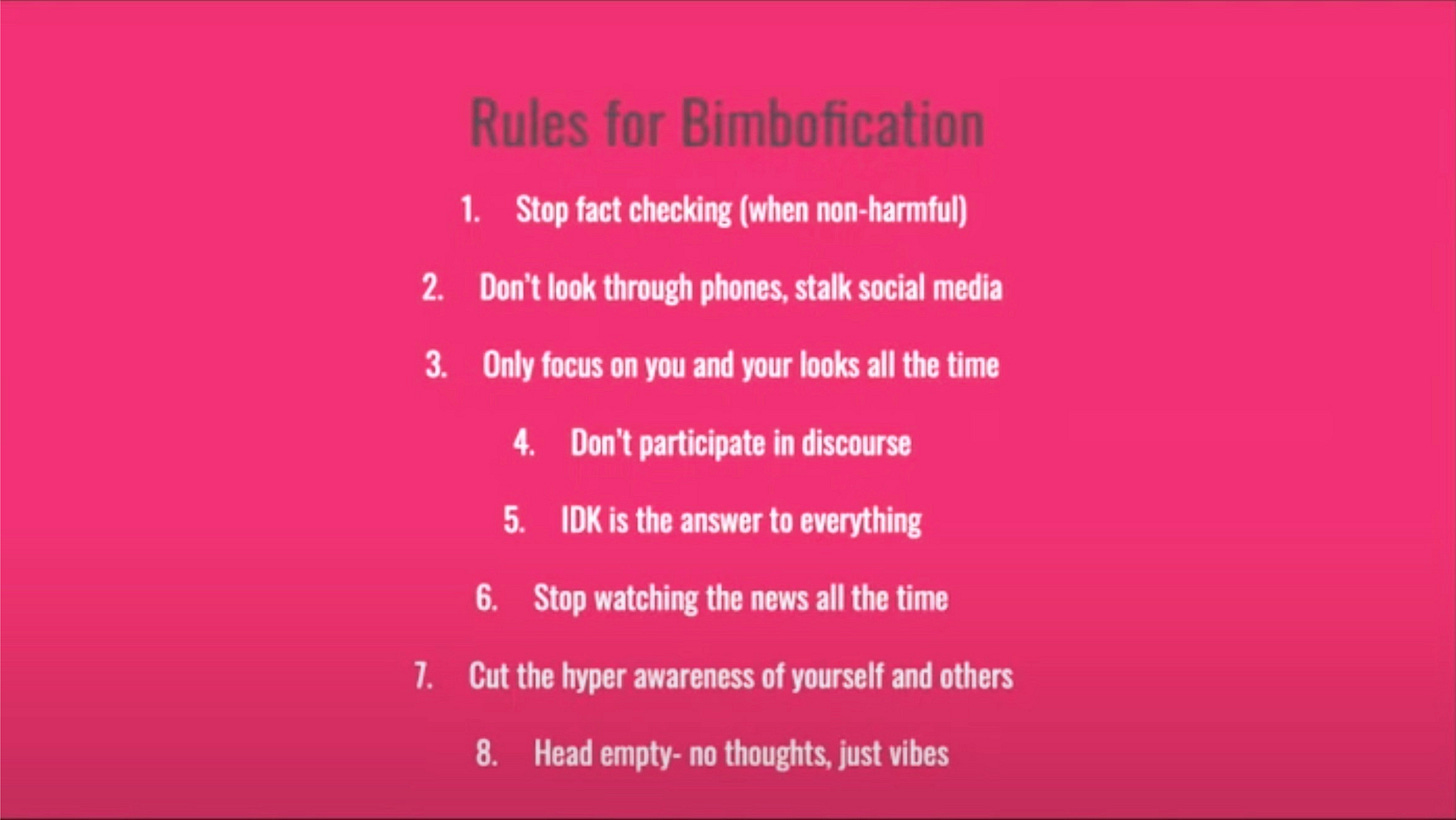
Her session helped me better understand the role of vibe consciousness in protecting one's mind while online. I asked her about the origins of her manifesto, and she spoke about a past narcissistic abusive relationship and how she responded with the tactic of “grey rocking,” the basis of her bimboism: a non-responsive form of behaving when one is being socially manipulated.
In narcissistic abusive relationships, the abuser “gaslights” the abusee, making them doubt their ability to assess reality, forcing reliance on their presumably superior ability. This can happen quite intentionally with those with Cluster B personality disorders, but the phenomena can also occur via “unconscious gaslighting.” In conscious and unconscious cases, the gaslighter invokes doubt in their target's intuition, memory, and reasoning capacities. They often speak as if they are the representatives of truth itself, aka propositional knowledge. If the abuser has greater ability in verbal intelligence and emotional self-regulation (and lacks “emotional integration”), the abusee is disadvantaged in conflictive conversations, regardless if they are in the right.
There is a good reason why gaslighting was Merriam-Webster’s word of the year for 2022—it is happening on the internet en masse via toxic marketing, fifth-generation warfare, and the so-called culture war. The “sensemaking crisis,” our inability to make sense of what is real, is gaslighting writ large. Multiple parties attempt to make us doubt our reality and orient us toward something not in our best interest.
Attention merchants, culture war profiteers, secular gurus, cyber magicians, Black PR firms, and any sociopath with an internet connection are in the gaslighting game. The internet is a PsyOp playground. Vibe consciousness is an evolutionary adaption to the cartoonish gaslighting levels we face. Rules like “No Thoughts, Just Vibes” stop any tacit agreement to cohere on what is real via propositional knowledge, allowing one to sink into non-propositional knowledge, betting on trusting the vibes instead.
This is not an unproblematic strategy, as it could lead to naive spiritualism or reverse gaslighting. Yet, practicing such tactics will provide one with what cybersecurity professional Patrick Ryan calls “psychosecurity” (PsySec)—protecting one’s mind against mental malware. While Stoicism is an old PsySec that bets on trusting the primordial vibe of “the daemon,” the likes of Fiona’s bimboism show new flavors of vibe-trusting PsySec are emerging.
All forms of PsySec encourage a bounded distrust of anyone privileging the mind to make sense of the world. A bounded distrust of the mind is the basis for a bountiful trust of the body.
Sensefulness > Making Sense
In her The Hollow series at The Stoa, organizational futurist and philosopher Bonnitta Roy introduced the phrase “sensefulness.” She argues that we are moving away from the myth of being in an information commons, with shared explanations with our minds via propositional knowledge, toward a shared understanding with our bodies via relational intimacy, or what she calls “senseful co-presencing.” Those following The Stoa for the last three years should not be surprised by this prediction: a sensefulness movement will supersede the mindfulness movement.
If my read of the nascent “wisdom commons” - a place that attempts to make wisdom more common - is accurate, sensefulness-based practices focusing on the sensate body over the construal mind are gaining traction and will soon surpass mindfulness-based practices in popularity. An argument for sensefulness-based practices is that they provide all the benefits of mindfulness-based interventions while avoiding the top-heaviness of being mind-full, embodying the truth that we are animals with “bodyminds,” not mind’s with a body.
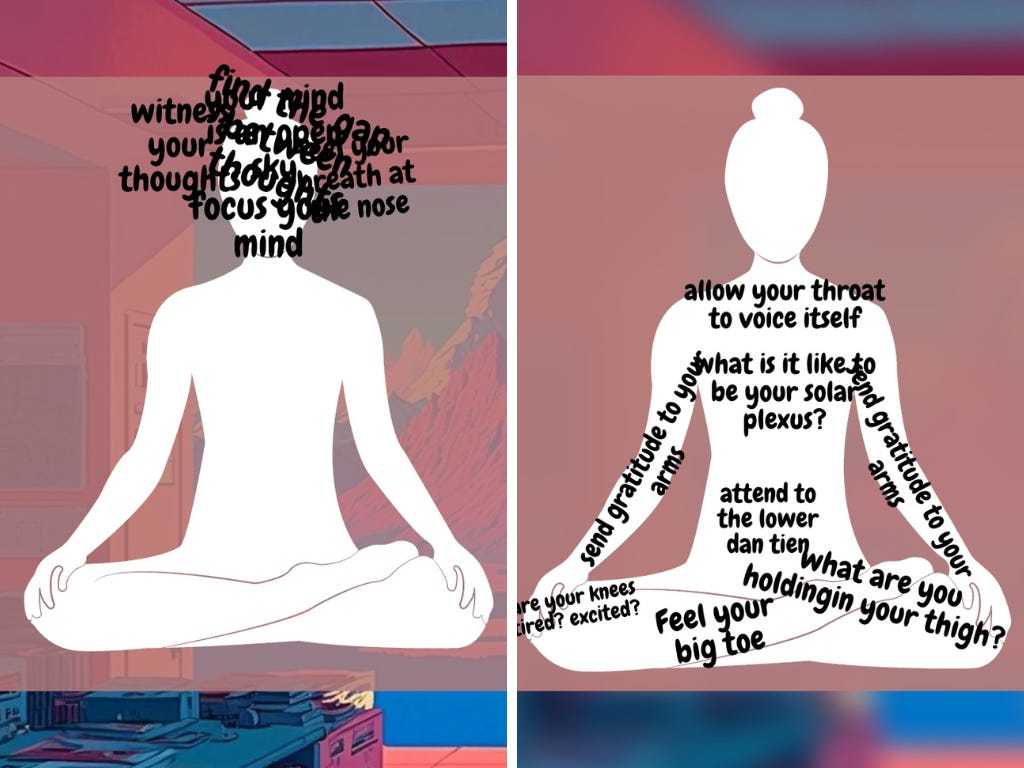
The move from mindfulness to sensefulness will occur because a full-bodied experience is needed to be a whole human animal. Like most things, divides such as sensefulness and mindfulness will blur with more practical interaction. The overarching movement with such interaction, to quote Bonnitta, is that we will be “putting the mind back in the body and the body back in nature.”
This focus on sensefulness will also help our “sensemaking,” in ways that initially may not make sense. Sensemaking or sense-making is a term that originated in organization studies, effectuating different schools, such as “Naturalised Sense-making” from Cynefin Framework creator Dave Snowden, who defined sense-making as: “How we make sense of the world so we can act in it.” It makes sense to want to make sense of the world; to do that, we need the capacity to make sense of what is relevant for us in the here and now, and for that, sometimes we need to allow things not to make sense.
Corecore, a phenomenon happening on TikTok right now, is not trying to make sense but is something to be sensed. The genre consists of a compilation of random clips invoking various feelings. The naming of the genre is a response to the many microgenres employing the suffix "core": cottagecore, cabincore, bloomcore, dreamcore, normcore, which appear on hashtags across the internet. These microgenres have a particular aesthetic, displayed through images and videos, focusing on the innermost essence of "something." In contrast, corecore lacks a “core” and carries no intrinsic meaning. No thoughts, just vibes.
Kieran Press-Reynolds muses in his investigation that corecore is an anti-trend:
“The rise of corecore makes me think about trend exhaustion, how people are losing faith in fad forecasting and glossy media trend pieces. Whether intentionally or by accident, corecore is an anti-trend: it doesn’t ask anything of you; it’s simply a montage of random vibes. Yet there is still a kind of haphazard communal aspect to it, with dozens of viewers leaving comments about how they love corecore, how they relate to these videos like nothing else.”
As Kieran reports in a follow-up piece, corecore has taken a darker turn, with nihilistic overtones and discussions surrounding the genre’s political potential. A tendency I see with many cultural commenters’ is their viewing of cultural phenomena through a political lens. This is misguided. We should not be scrutinizing culture by seeing ourselves as what Aristotle refers to as “political animals,” but midwifing culture by taking seriously German philosopher Peter Sloterdijk’s intimation that we are “practicing animals.” We are both, of course, but seeing ourselves practicing toward something rather than gaining power for something will offer freeing insights.
Looking through Sloterdijk’s practicing animal lens, what are corecore artists practicing? They are not practicing mindfulness or sensemaking, but a primitive form of collective sensefulness. Unlike other "core" microgenres that cultivate specific, describable vibes, corecore’s “random vibes” put our focus on nothing in particular beyond vibe consciousness itself. Without the guardrails of a descriptive suffix, corecore artists attune their bodies to whatever vibes are at the core, increasing their senseful capacities.
Those familiar with emotional integration work know that fully experiencing emotions is required to release their power over us, moving toward greater individuation, which Jungian therapists consider a whole state. When doing “the work,” a gravitational pull toward “unmet” emotional states (or “subpersonalities”) occurs, and these states are often unpleasant, with no home to express in polite society. I chalk up corecore’s dark turn to a senseful orientation toward wholeness. If the work continues, the “good vibes” will come, and any expressed vibes need not be shamed, with Carl Jung’s proclamation needing to be heeded: “I would rather be whole than good.”
Corecore may unfold toward greater wholeness or fade in shamed vibes. A genre name or style is not what is essential. What is being practiced is. It would be a mistake to see corecore simply as a practice of DIY art therapy because something more senseful is happening. To make another prediction: the practitioners of corecore are creating the “cave art” of Marshall McLuhan’s foretelling of a post-literate society.
This will not be a non-literate society but a society with an additional “literacy” of vibes—a literacy needed for a new type of tribe to emerge.
Vibe Tribes > Memetic Tribes
In 2018, I co-authored a philosophical report with Conor Barnes titled “The Memetic Tribes Of Culture War 2.0,” where we explored “memetic tribes”: living philosophies online. We tracked 33 of them, and for many, the highlight of the paper was an embedded spreadsheet that looked at the “philosophical anatomy” of each tribe: telos, sacred values, master status, existential threats, combatants, campfire, chieftains, mental models, and forebears.

I have had countless requests to update this spreadsheet. There are too many tribes forming, meshing, and bifurcating for me to want to do this, and tracking memes is now the wrong move. While my noosphere cartography days are over, I stay sensefully attuned to new and emerging living philosophies. A new one worth attuning to is TPOT, short for “This Part of Twitter.” They are also called the “ingroup” (with no clear “outgroup”), a homage to Scott Alexander’s article “I Can Tolerate Anything Except the Outgroup.”
Unlike Scott, whose views normally pattern-match him as a “rationalist,” TPOT is often pattern-matched as “postrationalists,” or postrats. The philosophical influences of postrats come from blogs such as Venkatesh Rao’s Ribbonfarm and Dave Chapman’s Meaningness. A good explanation of those drawn to postrationality comes from TPOT-habitué QC: “the esoteric meaning of “postrationalist” is a person recovering from the totalizing memes in the rationalist ecosystem.”
The rationalist project prioritizes the refinement of one’s “epistemic rationality” (improving accurate beliefs) and “instrumental rationality” (achieving your values) through being “less wrong” (e.g., being mind-full of one's cognitive biases) or how Eliezer Yudkowsky describes at the start of his “Sequences”: “rationality is about forming true beliefs and making winning decisions.”
The rationalist tribes' heavy focus on propositional knowledge is the cause of fatigue for many postrats initially drawn to them. My postrat friends are some of the most interesting people I know. They have incorporated the best of “applied rationality” and are experimenting with non-propositional ways of knowing through intersubjective practices like Circling, psychotherapeutic modalities like Internal Family Systems, and Buddhistic meditations that focus on the Jhānas.
It is no surprise to me, given their sensitivity to non-propositional knowledge, that TPOT is one of the healthier tribes on Twitter. Like Dimes Square, bimboism, and corecore, TPOT is a “vibe tribe” rather than a memetic one. It has a distinct vibe, with a definite sense of “ingroup.” However, with no clear memetic borders of what represents them, they do not have a clear “outgroup,” contributing to their eluding of the culture war.
Brooke Bowman helped organize Vibecamp, an in-person gathering of TPOT. As Brooke retells in her session at The Stoa, the event received lots of buzz through memes on Twitter, with many wondering if the event was even real. Adding to the intrigue, there were very few phones out and very few pictures taken during the event, presumably to respect the attendees' anonymity, many of whom tweet pseudonymously. As previously mentioned, vibes are about experiencing, not replicating, and experiencing requires greater relational intimacy, hence privacy, than memes allow.
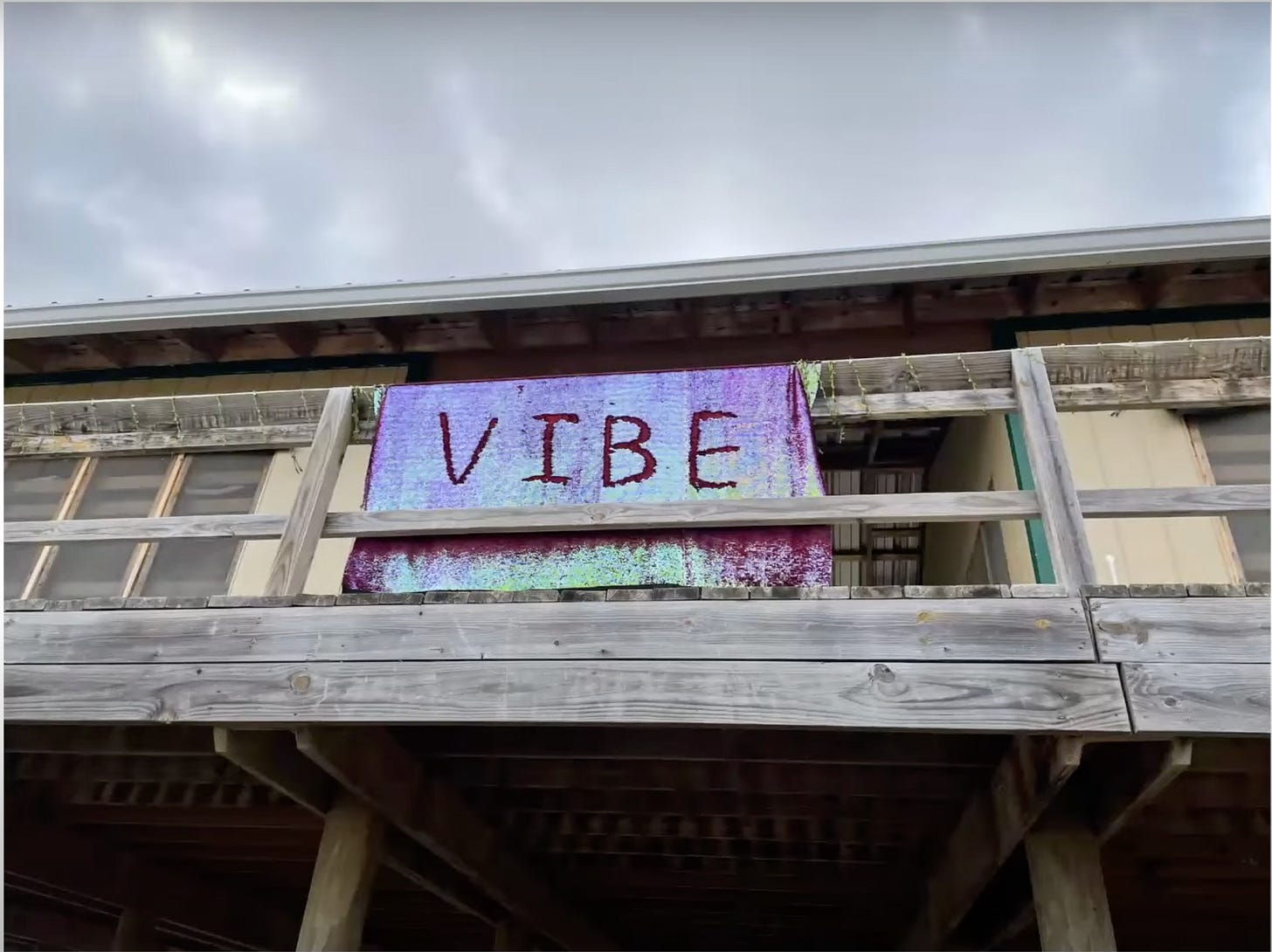
While memes have vibes, vibes have memes and antimemes—a term from qntm's book There Is No Antimemetics Division, referring to memes with self-censoring properties, discouraging their spread. Those sensitive to vibe consciousness, like the attendees of Vibecamp, can weave between memes and antimemes, sensefully discerning when to share something and when not to. Vibe tribes will shapeshift with a protean quality, not staying too long with any one memetic attractor, using antimemes to connect directly into vibe consciousness, leading to cohere IRL with senseful discernment.
In Monahan’s piece on the vibe shift in The Guardian, he articulated the sentiment those drawn to vibe tribes feel after the Covid moment ended: The internet is mundane. Real life is where the action is. Like with TPOT’s Vibecamp, the natural movement with those connecting through vibe consciousness is to relate IRL intentionally. The internet allows many to “find the others,” finally allowing them to cohere with those they vibe with. To make one more prediction: vibe tribes will be a vanishing mediator between memes and bodies, sensefully leading to bountifully trusting embodied tribes.
Those reading this essay who feel pulled bidirectionally - vibing IRL and memeing AFRL - can consider the following question...
Will we continue to be gaslit by bots and sociopaths while senselessly trying to make sense, or will we free the mind, feel the body, and find the others?
If we choose the latter, vibing wisely will be needed.
Wise Vibes > Good Vibes
Good Vibes Only.
This is the motto for “toxic positivity,” a dysfunctional emotional strategy that ignores, and worse, shame, depressive states, and aggression-inducing emotions like anger. Toxically positive people maintain “good vibes” without emotional integration and do not receive the wisdom of socially unpleasant feelings.
A “bad vibes fallacy” then forms. Those with “bad vibes” must be wrong because they are not positively presenting their claims. This is a fallacy because the vantage point with dark and depressive states can afford one to see aspects of reality that would otherwise be missed by those doped up on good vibes.
Inverse arguments against toxic negativity and a “good vibes fallacy” are also true. People can glamourize their dark and depressive states, projecting them on others with sophisticated political and philosophical argumentation, unfairly insinuating that anyone “too happy” should be dismissed because they appear cult-like or lamely wholesome.
Those with good vibes shame those with bad ones, and vice versa. To end the shaming, a temptation to define the terms might arise, which will prove controversial, putting one in the propositional realm without definitional consensus. It could also inspire the postmodern move to do away with the notions of good and bad altogether. I suggest we do neither of these moves and honor our sense of good and bad vibes instead, without defining them, as we will not readily cohere propositionally. And our sense of good and bad will not go away by arguing the categories of good and bad are not real. There is a third attractor, which relates artfully to all the vibes.
If a “vibe episteme” is forming, as Robin James suggested, how will a “vibe teche” form? Episteme is the Greek word for knowledge, and teche means art. To have artistry with vibes, one must work with all of them. Findings in “emodiverstiy” research show that those who experience diverse emotions predict mental and physical health, which maps over to the experiences of those doing emotional integration work and other sensefulness-based practices. Similarly, we can surmise that a “vibe diversity” is equally desirable. Experiencing diverse vibes presumably allows one to weave between them, affording greater discernment to know what vibes are wise to navigate life with. This is the art of a vibe teche.
All else being equal, good vibes may be more desired than bad ones, but wise vibes are the best. In psychologist Igor Grossman’s wisdom research, he defines wisdom as the “meta-value that adjudicates between all other values,” and “navigating life well” is the definition of wisdom I am presently vibing with. Wise vibes are the meta-vibes that have access to all the vibes, adjudicating between and navigating with the ones that present themselves to our bodies.
For successful navigation, aspirational directionality is needed to orient one’s body sensefully. For this, spectrums of intrasubjective states that psychotherapeutic and meditative practitioners use could prove helpful. Here is a simple one that metamodern philosopher Daniel Görtz introduced at his Philosopher-in-Residence series at The Stoa…
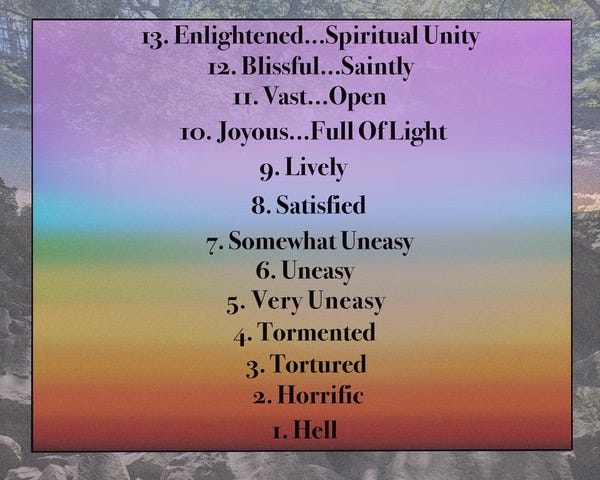
Those uncomfortable with the Buddhistic or Christian framing at the top or bottom of this spectrum may consider spiritual north and south stars from different traditions or be spiritual entrepreneurs and create their own. The Stoic bias is toward “eudaimonia,” which translates to “good daemon” or “being in a good relationship with the primordial vibe of the daemon.” A modern translation of eudaimonia could also be used, such as happiness.
Since wisdom does not stay in the propositional, I will shift the vibe of this report and share a personal perspective. As a weird Stoic, I vibe with people by asking philosophical questions at random times. A question I asked my barber Sebastian recently afforded me insight into happiness. The question was this:
Who is the wisest person you know?
He paused upon hearing my question, then said his mother. He told me she had a difficult upbringing in Chile and was not formally educated, but she was the happiest person he knew. In her twenties, she chose to be happy, which improved her life, leading her to a wonderful husband and a beautiful family. His answer took me aback because I realized I had never made this choice myself.
Like many people, sometime during my late teens, I associated happiness with something uncool and untrustworthy, which I now know came from a deeper sense of being unworthy. When Sebastian told me about his mother, I thought about the happiest people I knew, and one of them was Sebastian. At that moment, I felt the wisdom of his mother vibe through him to me.
It’s simple, really: developing a vibe teche starts with a choice.
Conclusion: Go on a Vibe Diet
To summarize the central premises of this report...
The use of vibe words is a lay phenomenology of an emerging vibe consciousness.
The vibe shift is a cultural shift from meme consciousness to vibe consciousness.
Vibe consciousness leads to three goods: PsySec, sensefulness, and vibe tribes.
PsySec helps you free the mind.
Sensefulness helps you feel the body.
Vibe tribes help you find the others.
Wise vibes are superior to good and bad ones.
I will commit to one more premise: a vibe diet is a way to form a vibe teche that will afford sophistication with vibe consciousness.
There are no epistemic authorities on vibe consciousness. There are no technical authorities either. Those of us shifting the vibe are in the wild west of the noosphere, co-discovering the frontiers together. Experimentation is needed.
I have been focusing on a vibe teche over a vibe episteme, thanks to my Stoic bias for practice over theory, and experimenting with the Stoic heuristic via negativa - studying what not to do - has led me to go on a “vibe diet.” A diet refers to the entirety of food one chooses to consume and is colloquially understood as restricting one’s dietary choices. In contrast, a vibe diet can be understood as the entirety of the vibes one chooses to experience and a restriction of one’s vibrational choices.
By restricting my engagement of the three sins of meme consciousness: zombie scrolling, doomscrolling, and pornification, I have been making more room for the three goods of vibe consciousness: PsySec, sensefulness, and being with the vibe tribe forming at The Stoa. I have noticed increased happiness during my vibe dieting—the practice of saying no has led to a greater agency to say yes.
***
To conclude this report, I will address those with a philosophical orientation.
Despite my criticism of the overdependence of propositional knowledge, and my advocacy of non-propositional knowledge, I think being coherent with one’s propositions is essential. Those like me who are sticklers for having their premises coherent and correspondence amongst premises and actions will not be happy with the “be happy” gesture in the previous section.
Why be happy? The answer will seem like common sense to many and will not need a response, or they will give a muddled answer along the lines of “because it feels better than being unhappy.” If we stay within the propositional realm, we will eventually bump into David Hume’s “is–ought problem,” which states that you cannot make claims about what you ought to do solely based on claims of what is.
Hence, even if we developed a body of propositional knowledge through a verifiable vibe episteme or a body of procedural knowledge through a validating vibe teche, if the “is-ought problem” remains unsolved for you, the gap between is and ought will be unbridgeable through propositions alone, resulting in core premises not being actuated. Responses to this problem exist. Alasdair MacIntyre has a good one; Sam Harris has a scientism-flavored one.
Philosophy is an intimate practice, and I sense it is wisest for you not to borrow the conclusions of another person’s inquiry, and engage in your own, because wrestling with philosophical problems builds character. It might lead you to some dangerous mind-full territories, which it did for me, but if your inquiry gets you to the other side of the gap, something meaningful awaits. While I will not share the specific conclusions of my inquiry, I will share the following...
***PHILOSOPHICAL SPOILER ALERT***
After your inquiry is exhausted, you will get to the bottom of all propositional knowledge and will be left with vibes and a choice. Your choice.
If you sense it is wise to make a vibrational choice, subscribe to this Substack for an upcoming announcement…

